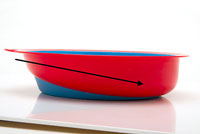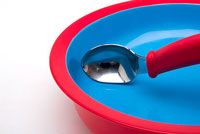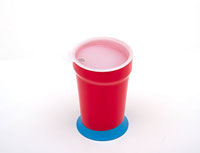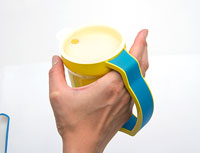The “small things” of care are particularly important in ensuring that care is genuinely supportive of the individual, and enhances that person’s autonomy and well-being. The humanity with which assistance for everyday living is offered, especially help with eating and intimate care, is crucial in helping the person retain their self-esteem and dignity, as are the manner and tone in which a person is addressed; the care taken to ensure that they participate as much as they can or wish in any decision about their day-to-day life; the trouble taken about appropriate and attractive food and environments; and access to meaningful activity.
Nuffield Council on Bioethics
Activities of daily living (ADLs) are the tasks we do during our daily lives. Because ADL skills decline as dementia progresses, caregiver involvement naturally changes over time. Caregivers often help more than is needed and research suggests that people with dementia—even those with advanced dementia—can do more than caregivers allow them to do.
Promoting independence requires good communication, patience, and the ability to understand and accept that dementia changes how a person approaches an activity. Many caregivers assume someone with dementia is no longer capable of understanding how to complete an activity and take over the task. This not only robs people of independence, it also affects their self-worth.
ADLs are generally divided into basic ADLs and instrumental or functional ADLs. Basics ADLs are the skills needed to take care of personal needs such as:
- Eating
- Bathing or showering
- Grooming
- Walking
- Dressing and undressing
- Transfers
- Toileting
Instrumental ADLs (IADLs) are the skills needed to function within society and within the community. As with basic ADLs, these skills decrease as dementia progresses. For example, when a person is no longer able to perform basic math calculations, a caregiver or financial advisor must oversee finances. When insight becomes limited and memory compromised, medical decision-making and medication management will also shift to the hands of a caregiver. Guardianship and capacity evaluations are often needed, especially when estate and legal issues need to be addressed (DeFina et al., 2013). IADLs include:
- Housework
- Financial management
- Shopping
- Preparing meals
- Communicating with the outside world
- Medical management
Strategies for Promoting Independence in ADLs
Even with proper training and mentoring, it’s nearly impossible to be a great caregiver all of the time. It’s no fun getting up in the middle of the night to clean up after an incontinent family member. It’s almost impossible to be patient when your mom swears at you, screams, hits, bites, collapses during a transfer, or refuses to eat. But the training I found online and the support from hospice helped a lot—it gave me strategies and techniques to use when all seemed lost and when nothing was working.
Family Caregiver, California
Good Communication Is the Basis for Success
Good communication starts with patience and thoughtfulness. Good communication builds trust, encourages independence, and leads to better outcomes. Caregivers must learn and believe that consistently trying to understand the needs of the person they are caring for will make their job easier. Good communication takes into account a person’s ability to comprehend, their sensory abilities, and their culture.
In the home setting, communication may be easier because the environment is familiar with fewer distractions although caregivers are often alone and cannot turn to a co-worker for help. No matter what setting, a calm tone, short direct sentences, a slow rate of speech, and patience encourages independence in people with dementia.
Clara
Clara is a 96-year old, Caucasian woman with severe macular degeneration, significant hearing loss, and moderate to severe dementia. Her caregiver has a thick accent and doesn’t understand that Clara can’t hear her and often can’t understand what she’s trying to say. The caregiver sometimes forgets to give Clara her hearing aids, sometimes puts the hearing aids in with dead batteries, leaves the TV on when trying to talk to Clara, and speaks in long, complicated, thickly accented sentences. She uses phrases and words that are completely unfamiliar to Clara. For example, when the caregiver wanted Clara to wipe herself after she finished urinating she asked Clara to “wipe her jewel.” Clara had no idea what she was talking about. Clara always tries to respond to her caregiver, even when it’s clear she has no idea what she’s being asked to do. Because Clara responds, the caregiver swears Clara understands her and is just being stubborn when Clara doesn’t do what’s asked.
ADL Skill Training
ADL “skills training” is recommended for all caregivers—both family and professional. Emphasis is on encouraging independence in all activities while providing appropriate assistance when needed. ADL skills training promotes involvement in self-care, minimizes caregiver stress, and reduces the amount of physical labor required of a caregiver.
A skilled caregiver learns to continually assess the strengths, comprehension, and capabilities of the person they are caring for. More or less assistance may be needed depending on the task, the time of day, co-morbidities, and level and type of dementia. For example, a person who is otherwise capable of independent self-care tasks but has poor balance might need help setting up a place to safely brush her teeth and do other grooming. If forced to stand during these activities, the person will likely need more help from the caregiver than is needed if a suitable sitting area is arranged.
Caregiver skill training provides caregivers with information, strategies, and tools to develop an individualized program that provides just the right amount of assistance. This might involve gestures, verbal and visual cues, assistive devices, planning and problem solving, and physical assistance.
Planning Activities
Planning an activity for someone with dementia must take into account their abilities and interests, which promotes success and leads to a wider range of activities. Well-planned activities will naturally arise from a careful assessment of a person’s lifestyle, occupation, interests, and preferences. For example, a person who loved to go for hikes but can no longer walk will still enjoy going for a drive or visiting a park with paths that accommodate wheelchairs. That same person may not enjoy sitting in front of a television tuned to a game show.
Assistive Technologies
Assistive technologies—devices designed to enable people with a disability to function more independently—have been developed to support people with dementia and their caregivers. Assistive technologies focus on safety and social participation. They are different than assistive devices, which aid with mobility and physical activities of daily living.
Assistive technologies:
- Provide the caregiver with a way to make sure the person they are caring for is safe.
- Provide help with memory and recall.
- Improve a person’s confidence and independence.
- Keep people with dementia socially connected.
Examples of assistive technologies include:
- Face-to-face communication with family members and friends using tablets or computers.
- Tracking devices that allow a person to walk independently within a safe area.
- Electronic prompts and medication reminders.
- Medical check-ups via telephone or video conferencing.
- Automated lights.
- Automated shut-off sensors that prevent flooding, turn off devices that have been left on, or turn lights on or off.
- Communication aids such as adapted telephones with pre-set numbers.
- Cameras mounted throughout the home.
Assistive technologies can reduce the cost of care, decrease caregiver burden, promote independence and autonomy, and increase quality life for people with dementia. They may also promote aging in place, delay transfer into a care facility, and help people with dementia maintain independence (Czarnuch et al., 2016).
Adaptive Aids
Adaptive aids are devices and equipment designed to assist a person with daily activities such as mobility, transfers, dressing and grooming, bathing, and eating. They can help individuals with disabilities compensate for lost functions, increase their independence, and develop their potential (Yeung et al., 2016). The selection of an adaptive aid or device depends on the person’s level of dementia, preferences and lifestyle, and physical abilities.
Adaptive aids include:
- Safety devices such as grab bars, transfer poles, handrails, and non-skid mats.
- Assistive devices such as walkers, wheelchairs, braces, height-adjustable chairs and beds, pulleys and slings, ramps, and lifts.
- Devices to assist with eating and drinking such as non-tip cups, assistive tableware, non-spill cups, adjustable-height tables, and easy-grip silverware.
- Devices for washing and bathing such as commodes, shower chairs, transfer benches, and walk-in or roll-in showers.
- Devices for household tasks such as adjustable-height cupboards, reachers, grip extensions for appliance controls, and pull-out shelves or pull-down shelves.
Preventing Loss of Independence through Exercise
Conventional exercise programs such as walking, resistance training, and seated exercises that focus on improving aerobic endurance, strength, balance, and flexibility have beneficial effects on physical function in individuals with cognitive impairment and dementia. Exercise improves the ability to perform basic activities of daily living such as eating, dressing, bathing, using the toilet, and transferring from bed to chair (Barnes et al., 2015).
Environments that are dementia friendly and safe promote independence and physical activity. This can include developing environments that are safe to walk around and navigate, environments that are not confusing, and policies that limit unneeded moves from one facility or area to another (Handley et al., 2015).
Care Techniques
Care techniques are the skills needed by the caregiver for monitoring, assisting, and providing total care in dressing, grooming, eating, bathing, or toileting and incontinence.
Dressing and Grooming
As with other activities of daily living, people with dementia often need time to dress and groom. The caregiver must assess the person they are caring for to determine the amount of help needed, must be patient, and must resist jumping in to help if no help is needed. Depending on the severity of the dementia and co-morbidities such as visual and perceptual changes, balance, and strength—even the time of day—caregivers must train themselves to encourage as much independence as possible.
For example, Clara, mentioned in the case example earlier in this section has severe macular degeneration and fairly severe dementia. But she is very flexible and fairly strong. When she’s sitting in a chair with proper back support she can easily bring her knee up to her chest. However, she can’t see where to place her leg when she tries to put on her pants. It’s tempting to do everything for her but this increases caregiver burden and fails to promote Clara’s independence. In this case, the caregiver must be patient—help Clara lay out her clothes and provide verbal and appropriate touch cues to direct the activity.
The same is true for grooming. For mouth care and other grooming tasks, go step-by-step, providing a safe and comfortable place for grooming. For men, encourage the use of an electric razor and for both men and women, encourage regular visits to the beauty or barber shop.
Eating and Hydration
Interventions to support older people around eating and drinking vary: changing the color of a plate, increasing exercise, altering the environment or changing knowledge or attitudes. Some interventions alter food and drink directly via oral nutrition supplementation, food modification, dysphagia management, eating assistance or supporting the social element of eating and drinking. Other interventions such as altering the dining environment, providing education and training for people with dementia and their caregivers, behavioral interventions, and exercise programs affect food and drink intake or experience indirectly (Bunn et al, 2016).
Assistive or adaptive tableware have been a mainstay in nursing homes and assisted living facilities for many years. Unfortunately, most assistive tableware lacks aesthetic appeal. Since people have different needs and abilities, and assistive tableware stands out from standard items, users of assistive table settings may feel stigmatized.
A common strategy as dementia advances and feeding difficulties develop is to simplify eating by providing just a plate and spoon with pureed or diced food that can be eaten without needing to be cut up by the resident. The plate should have a high lip that helps to push the food onto the spoon as a person tries to scoop it up.


The slanted bottom hip lip of the plate can help users to gather food on one side without scooping. Spoon heads are designed to match the curvature of the bowls to pick up the food easier. Designed by Sha Yao, Eatwell.com. Used with permission.
Well-designed assistive tableware can be used by people of all abilities and should resemble standard domestic tableware. Color contrasts should feature prominently—for example royal blue plates provide a contrast both with a white table covering and food on a plate. The same approach can be used with cups; for example, royal blue and white can be used to help those with low visual acuity or agnosia locate the handle and rim. The sides of the cup should be angled to reduce the need to tip the cup, a large handle will assure a good grip, and the top should be wide enough to allow a person’s nose to fit inside the cup when tipped.


A cup with a weighted bottom is shown on the left. A cup with an easy-to-grip handle is shown on the right. Designed by Sha Yao, Eatwell.com. Used with permission.
Interventions that have shown particular promise include: eating meals with caregivers, family style meals, soothing mealtime music, constantly accessible snacks, longer mealtimes, education and support for formal and informal caregivers, Montessori activities, facilitated breakfast clubs, and multisensory exercise. More research is needed to help understand what types of interventions are effective in supporting adults with dementia to eat and drink well, and to remain actively engaged with food and drink (Bunn et al, 2016).
Bathing
Throughout our lives, bathing is a private, independent, and personal experience. For someone with dementia, having another person help with bathing can be uncomfortable and even threatening. Success depends on a caregiver’s ability to help the person they are caring for feel a sense of control and independence. This is accomplished by including the person is the bathing decision, encouraging independence, protecting the person’s privacy and dignity, and practicing flexibility.
Prepare for bathing by making sure the environment is safe and comfortable. Bathing supplies should be within reach and the water pre-heated to the proper temperature. Grab bars should be available as well as non-skid mats.
During bathing, techniques that comfort and reassure a person with dementia include:
- Set a regular time for bathing
- Be gentle with fragile skin, avoid scrubbing
- Simplify the bathing process, use assistive devices
- Coach or cue the person through each step, if needed
- Offer a bench or shower chair for comfort and safety
- Cleanse hard-to-reach areas
- Use a sponge bath in between baths or as an alternative to bathing (Alzheimer’s Association, 2016b)
Toileting and Incontinence
Incontinence is the involuntary leaking of urine or feces or both. For people with dementia living at home, incontinence can be embarrassing and stigmatizing. Incontinence adds to caregiver stress and depression and is a factor in the decision to admit a family member to a care home.
A number of issues are related to toileting and incontinence in people with dementia. Some are the result of the loss of cognition and memory, some from behavioral and psychological symptoms and some from the interplay of these with other comorbidities. Over-medicating with laxatives (sometimes without the knowledge of the caregiver) can be a problem. Toileting and incontinence issues can include:
- Unable to act in a timely way to the sensation of the need to void.
- Unable to locate, recognize and use toilets or undo locks on toilet doors once inside.
- Unable to manage things such as undoing and replacing clothing, for men how to direct the penis, and how to undertake cleansing and personal hygiene.
- Inappropriate management of soiled clothing as well as urine and feces, hiding soiled underwear, attempting to hand feces to the caregiver, wiping feces off hands onto clothing or furniture.
- Voiding in place without trying to remove clothes or move to a toilet or commode.
- Choosing to void in an inappropriate place such as defecating in the garden, standing by the bed at night, or in inappropriate receptacles such as waste bins.
- Resistance to others helping with toileting (Drennan et al., 2011).
Techniques and strategies used by caregivers to manage toileting and incontinence in a person with dementia typically start with reminders to go to the toilet on a regular basis. As dementia progresses, other techniques are needed such as adult diapers, bedside commodes, and direct help from the caregiver.
To make it easier for a person with dementia to find and use the toilet:
- Clear the path to the bathroom by moving furniture.
- Keep the bathroom door open so the toilet is visible.
- Put colored rugs on the bathroom floor or put a picture of a toilet on the bathroom door.
- Make the toilet safe and easy to use. Raise the toilet seat, install grab bars on both sides, and use nightlights to illuminate the bedroom and bath.
- Consider a portable commode or urinal for the bedroom for nighttime use.
- Remove plants, wastebaskets and other objects that could be mistaken for a toilet.
- Remove throw rugs that may cause a person to trip and fall.
- Consider using glow-in-the-dark tape to create a direct line or path to the toilet (Alzheimer’s Association, 2016c).
Keep in mind that incontinence can be related to a medical problem such as urinary tract infection, constipation or prostate problems. Incontinence is also associated with diabetes, stroke, Parkinson’s disease and physical disabilities that prevent the person from reaching the bathroom in time. Medications and diuretics (drugs that increase urination) can also cause incontinence. This includes sleeping pills, anxiety-reducing drugs that may relax the bladder muscles, and drinks such as cola, coffee and tea (Alzheimer’s Association, 2016c).
